First of all what is a Bug Out Bag?
Quite simply it is a bag packed with basic necessities to keep you alive or if you needed to leave or ‘bug out’ of home. As unlikely as a situation like that may seem, there are parts of the world that suffer from earthquakes and powerful storms on a regular basis and where preparation for these events is just part of a sensible routine. Many people take it a step further and prepare a bug out bag not just in case of predictable natural disasters, but in case of world-ending events such as nuclear war, the outbreak of disease on an epidemic level, or massive solar flares that might knock out electrical devices and hypothetically return us to a medieval level of technology.
There is a lot of advice out there suggesting that you need to prepare a bug out bag in case of the complete breakdown of modern society, invasion by a hostile nation, the actions of a corrupt and dictatorial government, or even zombies. Although being prepared for any of those situations would be good, let’s face it most bug out bags that have actually been used have been used for much more mundane reasons. Local evacuations due to gas leak, power outage, storms, are far more likely than zombies or government conspiracies. So pack for survival rather than for guerrilla warfare.
In some cases you will hear people talk not just about bug out bags but 72 hour kits and INCH bags. In some cases these terms will be used interchangeably but they are really separate concepts.
A 72-hour kit is a kit which gives you everything you need to sustain life for three days, these kits might not look too dissimilar to your average camping backpack; it doesn’t take much more than a little food, water, shelter, a camping stove, flashlight, sanitary and hygiene items, and EDC knife to live for 72 hours. Additionally, a 72-hour kit might not be designed to take you away from home, it might just need to be enough to give you a few necessities while power is restored or the floodwaters abate but is really an incomplete system for long term survival away from home.
They are really designed to be a stop-gap before assistance reaches you or before you can reach assistance and are recommended for everyone who lives in areas that suffer from extreme weather events such as hurricanes. Organizations like FEMA (Federal Emergency Management Agency) in the USA and the Office of Disaster Preparedness and Management in Trinidad and Tobago recommend a kit like this for everyone for the very reasons shown in this video;
A bug out bag, often shortened to ‘BOB’ is effectively an upgrade to a 72-hour kit and provides you with not only the necessities to feed, hydrate and shelter yourself from the elements in an emergency but the tools and equipment to prolong your survival away from your home.
An INCH bag is a similar concept but takes the short term survival of the BOB a little further as INCH stands for I’m Never Coming Home. Unfortunately most online searches for an INCH bag yield kit lists that are fatally flawed. The kind of kit that many people recommend for an INCH bag is often entirely impractical not to mention impossible to carry. I’ll mention INCH bags again at the end of the article and show you how you can turn your ‘BOB’ into an ‘INCH’ with the addition of a few simple items that won’t make it too heavy to carry.
A bug out bag if approached correctly should be an integral part of your emergency preparedness for shorter-term emergencies and if coupled with well-developed survival and bushcraft skills could be enough for very long term survival. In this article, I’ll focus on a stand-alone bug out bag but you should be aware that often a bug out bag will be combined with a pre-prepared bug out location in preparation for emergencies and the need to evacuate.
A bug out location is a safe haven that you can retreat to in a real emergency where you have stockpiles vital tools and resources to supplement the supplies in a bug out bag allowing you more time before you start having to rely on hunting, foraging, and subsistence agriculture to provide your food. If you have a prepared bug out location the primary purpose of your bug out bag is to get you to that location.
It’s true that setting up a bug out location is expensive and not within the means of many, and perhaps it is overkill for your average power cut or water shortage. Bug out locations often feature in plans for world ending events as a place of refuge in case of the breakdown of society but most people aren’t immediately going to head for the hills to become a hermit in the event a house fire, storm damage or power cut. Instead in those situations you will use the change of clothes, torch and other basic equipment in your bug out bag while you are waiting for power to be restored.
These more realistic disaster scenarios; house fires and the destruction of property due to floods are a great reason to pack personal records or vital documents, or at least copies of them, in your bug out bag. Items like driving licenses, passports, birth certificates, documents that prove your ownership of your home, and other things that might be hard to replace after an emergency. This is one of the things that appear in my list of ten must-have items for your bug out bag, and while those documents won’t save your life in an emergency remember the point of being prepared for emergencies is so that as far as possible life as you knew it can resume after the emergency.
This will be difficult without those documents and even in the event of a world-ending event some documentation will still be useful; I include some brief documents on my family history in my kit as well as other vital documents so that should a real disaster occur those things will not be lost and can be shared with my children so they know a bit about where they came from.
Other than including your vital documents though what should you include in your bug out bag and how should you set it up?
Setting Up Your Bug Out Bag.
There are a few items which should just by the application of common sense be included in a bug out bag, things which no-one needs to be told to include in a kit, some pointers might be required to pick the best items to fill the needs of clothing, water, food, shelter and a pack but these things really are common sense and so we will discuss those things here before we get into the list of key items that might more easily be forgotten or overlooked.
Other than these common sense items one thing above all others that you must realise is that a bug out bag must be a COMPREHENSIVE survival system, not just a few supplies to keep you going until rescue. It must stand alone in an emergency without having to rely on rescue or on hand outs of food and equipment.
Before looking at those ten must have items there are a few basic preparations and categories of equipment that must go into your bug out bag, things which are common sense and which anyone used to packing a rucksack for a camping trip, or indeed a suitcase for holiday, would think to pack.
Shelter
You need to be prepared for any situation, and as shelter is almost always the first priority of survival we will discuss that first. Being effectively prepared for a survival situation means packing for winter rather than summer so that you will be able to survive whatever time of year disaster might strike.
The first priority of survival is almost always shelter; it is likely to be your most pressing need for a number of reasons for example in extremely cold conditions debilitation and death could occur in under an hour due to the harshness of the environment and so the priority will be a shelter in conjunction with a fire to provide the necessary warmth to sustain life. In arid conditions shelter again will be a priority as an effective shelter can dramatically slow dehydration.
Every piece of equipment that goes into your emergency kit must be capable of dealing with the worst possible conditions that you could expect to meet in an emergency in your area. This doesn’t mean that you pack a sleeping bag rated to keep you warm down to temperatures of minus 40 if you live in a hot place because “you never know it might happen” you have to be sensible about it and common sense will dictate what you choose to pack to deal with the worst conditions you may realistically encounter, and no one can teach you common sense.
So grasping firmly to our common sense we will first chose something to shelter us in the worst conditions we can expect to encounter. There are many things which shelter our bodies from the effects of the weather; Clothes are of course the simplest:
Clothes are our first line of defense against the elements and in an emergency, it is entirely possible that we will find ourselves dressed completely inappropriately for the situation so it is important that you always include a change of clothes in your emergency kit and perhaps most importantly a change of shoes. If you are going to be spending a lot of time on your feet a comfortable pair of shoes is essential, this doesn’t necessarily mean an expensive pair of boots just a comfortable pair of shoes that will keep your feet dry and warm and which won’t give you blisters if you need to do a lot of walking.
If you can afford to go to the lengths of putting a strong pair of boots aside for your kit that would be even better, your shoes/boots won’t necessarily need to be in the pack that you have your kit in but obviously close by. I keep an old pair of comfortable running shoes in my kit that means I have a pair of shoes which will be comfortable to walk in, walking boots are the popular choice for survival situations but actually are overrated especially if you are not used to wearing them. You’d be far more comfortable in running shoes. In case of a real emergency though I would make my boots the first ‘extra’ thing I would grab if I had time. A couple of pairs of thick socks will need to be in your kit alongside any normal socks you might choose to pack.
Just as with your shoes you need to make sure the other clothes you pack are comfortable and that they will keep you warm and dry. For this reason take clothes that are not too tight and are not prone to cause chafing, so breathable, quick drying, hard wearing materials are best. It is best to layer your clothing as carrying several lighter layers, as couple of t-shirts and thin jumpers will be warmer and lighter than carrying one very heavy jumper.
A word of caution about jeans, I would strongly recommend against including jeans in your kits among your clothing as although they are strong and hard-wearing if they get wet they stay wet and do not dry easily and they are prone to chaffing and irritating you while walking in them. A better solution would be polycotton trousers which dry very fast and are comfortable, military surplus stores are great for finding hard-wearing clothing suitable for emergencies alternatively an old pair of jogging trousers would be fine and very comfortable.
Waterproof clothing is again essential, although you can spend as much or as little on these as you want; it is easy to find waterproof gear that is very expensive but cheaper equipment is available too. You do generally get what you pay for and the more expensive waterproofs will be breathable and more comfortable than the cheaper options however as long as they keep you dry and you don’t sweat so much wearing them that you end up wetter than if you didn’t have any at all.
To save weight in your bug out bag a waterproof poncho is a great option, again these can be as cheap or expensive (there are believe it or not companies that produce semi-custom ponchos which will double as bivouac style shelters to order) as you want although it is hard to go wrong with a waterproof military surplus poncho. Not only will a poncho always provide good breathability it can also cover your pack or a small child being carried on your shoulders to keep them dry too as well as being used as a makeshift shelter for a really lightweight kit.
Tents and Bivi’s:
A bivi or bivouac is a makeshift shelter which is often lighter and easier to carry than a tent, when packing a kit for just one or two people it is easy to find a tent small and light enough to carry, or just use a waterproof poncho as an ultra-light weight shelter. The more people you need to put under canvas the heavier things get though, for example a five man tent may well weigh up to 20kg. It won’t be realistic to carry something that big or heavy as part of a bug out bag, even if one person carried the tent poles, one the fly sheet and another the inner tent that’s still too much to realistically carry. There are other options, carrying several small tents, a simple three man tent can be as light as 2 or 3 kg and it would be a more realistic amount to carry with two 3 man tents between five or six people than one larger tent. The other alternative is to make do with a bivi, some cheap tarpaulins and parachute cord can easily be used to set up an adequate shelter for several people. Tents are also likely to be more expensive than the bivouac alternative.
Also remember that a dry place to shelter can be a massive boost to morale; having a dry place to sit and where you can lay out your sleeping bag and keep your kit dry can seem like a huge luxury when you have very little left.
Remember no one has ever died in a matter of minutes or hours from starvation or dehydration but it is very possible to die from the effects of exposure in literally a matter of minutes if the conditions are bad enough so shelter should be a priority. Also remember that filling the requirement for shelter is likely to be the bulkiest part of your bug out bag; a bundle of clothes, waterproofs and a tent or bivi is going to take up quite a lot of space in a pack. As you add more and more kit to your bug out bag you will recognise that you need something to carry it in.
Packing
There is no finite 72 hour period associated with a bug out bag although realistically the amount of food you will pack won’t ever extend to much more than this due to weight implications. It just isn’t realistic to carry more than a third of your body weight for any length of time over rough terrain and the one thing that really defines a bug out bag is that it is meant to move, it’s going with you to wherever you are going whether that is a pre-prepared bug out location or just away as fast as you can.
First things first, the bag for your bug out kit needs to be strong, it must be large enough for all your kit to save you having to strap kit to the outside of your pack. A strong backpack is my recommendation, although careful consideration must be given to the health and physical capacity of the person carrying the kit as some physical conditions or poor health might make carrying a backpack difficult or impossible. In those cases consider a three wheeled all terrain trolley that can be pushed along and will provide support as well as load bearing capability.
Any load bearing solution you choose will probably need to be at least 65 litres in capacity but may have to be larger depending mainly on the weather conditions you are expecting, in a cold environment you will need a heavier sleeping bag, more clothes and special cold weather gear, all this will have to go into your pack and so a larger pack will be needed, maybe even up to 100 litre capacity. Most importantly though, however large your pack and whatever you have in it that it is comfortable, if you need to go far in an emergency it will almost certainly be on foot and your pack will have to go with you, if it is anything but comfortable it will make surviving your emergency far more uncomfortable than it has to be. In an ideal world a pack manufactured by a reputable brand of outdoor gear is the best place to start, however such a pack would be very expensive so even if you are shopping for budget friendly kit make sure you look for a pack with a proper harness with well-padded shoulder straps and waist belt. Also consider a chest strap to ensure the shoulder straps of your pack remains in a comfortable position not slipping too far off the shoulders or rubbing on any pressure points.
If you will be spending a lot of time on your feet with your pack on your back then it is important that all these features are considered conditions for your pack are met otherwise it will be easy to get painful sores and blisters where a pack without a proper harness has rubbed and irritated. As long as you are physically able though a backpack is the best for carrying your gear, this is true for many reasons but most importantly a backpack is the only effective and comfortable way to carry a load across uneven terrain, a grown man in reasonable physical condition can comfortably carry 25-30kg’s in a back pack and significantly more if pressed but imagine trying to carry that weight in a suitcase or a box. Even quite young children will with a small pack be able to carry at least their own clothes, some items of food and a toy in an emergency.
Once you have your nice comfortable pack with a well-padded harness that is a suitable size you must ensure that it is set up for you, you might not think that there is much setting up to do where a pack is concerned but on most packs you will be able to adjust the distance between the waist belt and the shoulder straps. This is important purely to make sure you are as comfortable as possible, imagine trying to wear some overalls for a person who is 5 foot 2 if you are 6 foot 5 or vise versa, it’s not going to be comfortable is it? So imagine if your packs shoulder straps are snuggly around your shoulders but the waist strap is nice and secure around your rear end, it will in the long run be equally uncomfortable. The waist strap on a pack should rest on top of your hips, it doesn’t need to be cinched so tight around your waist that it hurts it just needs to be tight enough to hold it on top of your hips and in this way it transfers the vast majority of the weight of your pack strait down through your legs to the ground rather than hanging it on your shoulders and tipping you over backwards. So obviously if these straps are not calibrated to suit your body shape you will not be as comfortable as you could be.
So once all this has been done, you have your pack, you’ve ensured it fits you properly and the straps are all in the right place for you, you need to pack it and if you pack it wrong however good the pack is it will still be uncomfortable. There are quite a few odd shaped and hard items that go into a 72 hour emergency kit and if for example there is a fuel canister for your cooker jabbing into the small of your back every step you take, or if it is packed so tall that every time you duck under a branch as you walk through a forest it snags on that branch you will pretty soon come to hate that inanimate object that’s on your back with a passion.
There are two general rules to remember when it comes to packing your bag; heavy items near to the top and as close to your back as possible. Sticking by these rules keeps the weight as close to your centre of gravity as possible and makes the pack more comfortable and stable to carry, stability is particularly important over uneven ground.
When you are packing your bug out bag it’s also important to consider a few things to make sure that things you need urgently are easily accessible. Remember you are planning for an emergency not just a backpacking trip and that might influence how you pack your bag. Most modern packs have two main compartments, a smaller bottom compartment which can be accessed either through the front of the pack or through the top once everything else is removed. I always pack my sleeping bag and spare clothes in this part of my pack. They are light and quite large although they can be compressed with compression sacks and vacuum bags. My sleeping bag is always the last thing I need when preparing for the night, but if for any reason I do need it or my change of clothes quickly it can still be accessed through the front of my pack. The first thing into the upper and larger compartment of the pack would be any spare clothes that didn’t fit into the lower part of the pack followed by food and some water. Cooking gear always goes pretty close to the top of my pack in case I want to brew up during the day and have some soup or a hot drink, I normally wouldn’t plan on eating hot food during the day as it is quicker to eat cold snacks while on the move to save time and to avoid the constant need to unpack and set up my cooking kit, but it’s always close to the top just in case. The very last thing in my shelter as it is always the first thing I will want so I can set up my place to sleep for the night, In an emergency you probably won’t be on the move every day but I would still have my shelter at the top of my pack so I can set it up first.
All that remains is the things in the outer pockets of my pack, snack foods, waterproof clothing to keep the rain off, first aid kit, water bottle anything that needs to be close to hand. Even consider attaching your first aid kit SECURELY to the outside of your pack in case you need it quickly.
Another point regarding packing is to ensure that everything is carefully waterproofed, obviously your pack is going to be made of a strong waterproof material but the likelihood is that the stitching and zips and openings on your pack are not going to be as weather proof. Nowadays it is possible to get waterproof zips and taped seems on your pack but this obviously increases cost and despite those excellent advances in packs I would always still tightly wrap my gear in waterproof bags. For the budget conscious simple rubble sacks or old fertilizer bags which had been thoroughly cleaned are perfect as they are tough enough to withstand abuse, unlike garbage sacks which are far too weak. There are excellent dry bags and waterproof compression sacks available to buy also but these can be expensive. To get your money’s worth though these can double as water carriers, flotation aids, bear bags (bags hoisted into trees to keep them away from scavenging wildlife) and many other things. Even without dry bags though a carefully packed kit will not only be watertight and safe from even the worst weather but it will also be air tight in its separate plastic wrappings and be very buoyant, so should you need to cross a river or body of water it will float like a cork and in the event of flood your kit won’t be lost or waterlogged.
Water
Water is one of the simplest items that will need to be included in you bug out bag but at the same time one of the most problematic. When preparing a bug our bag the 72 hour post emergency period is still important to consider as it is during this time that you will be most vulnerable and if you are prepared with food and water for this amount of time then it will give you time start gathering and foraging for more food and water. However 72 hours’ worth of water is extremely heavy.
For a period of 72 hours you will require a lot of water just for drinking. If you are expecting to be walking or doing anything active which is quite likely in the event of an emergency, possibly up to six litres each day, and at the very least two to three litres. Add to that the amount that you will need for cooking and personal hygiene and you are looking at, possibly up to ten litres a day. Each litre of water weighs a kilo. Thirty kilos of water is simply impossible to carry on top of the rest of your gear, and those thirty kilos are just for one person! You will have to pack some water, as much as you feel is practical to carry, I never carry less than 3 litres in my bug out bag but I also have a ten litre plastic jerry can with a webbing strap that I can carry over my shoulder that stays next to my bug out bag. That means between my wife and I, plus the two litres of water in my oldest son’s bug out bag and the one litre in my daughters that we have immediate access to nineteen litres of clean water.
For a family that is simply not enough even for three days so you will have to think of ways to save water and to supplement your water supplies.
Collecting Water
In temperate climates there are plenty of sources of potable water which can be taken advantage of. Rivers and streams are sources of some of the cleanest water but as long as water is properly purified there is no reason it can’t come from still water too.
In more extreme conditions there might be ice or snow to melt. But in extremely dry conditions where any sources of water are scarce it might be necessary to try and collect water from plants by collecting the water they produce through transpiration by covering the plant in plastic sheeting or with a survival blanket. Or in conditions where groundwater is accessible you could dig a well.
To ensure that you can carry and collect water foldable water containers and water bottles will be essential items of equipment, but you already have these in the form of the waterproof bags your clothing and shelter is packed into, so you do not have to worry about carrying extra weight to collect water.
Purifying Water
Collecting the water is only the first part of the solution though as any water collected will need to be purified to remove the risk of contracting water borne viruses and diseases.
Before purifying, any water collected must be strained to remove suspended particles, leaves, mud, silt etc.. that may be suspended in the water will irritate the digestive system and might lead to illness, the easiest way to do this is with some fine cloth or even a spare sock. Purpose built bags for filtration are available, the British Army’s Millbank bag is an excellent choice and something that costs very little and take up no space at all in the survival kit that you will pack into your bug out bag.
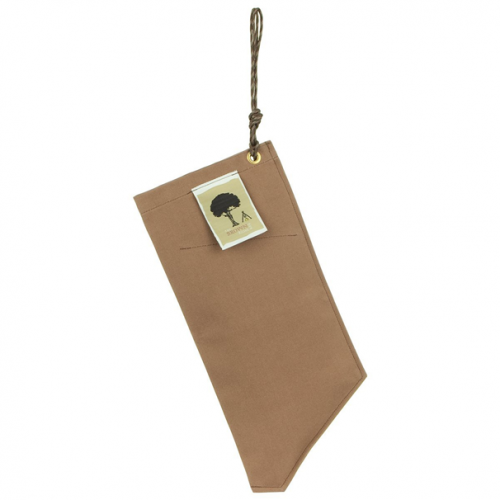
Once filtered purifying the water is a simple procedure either using equipment you have packed to purify water with or simply by boiling. Keeping your water at a rolling boil for two minutes will destroy any bacteria or viruses that may be in it. There are also plenty of chemical purifiers on the market that are cheap and easy to use. I also carry a small mechanical purifier which weighs only a few ounces and will easily purify a couple of thousand litres of water before its filters need replacing.
The demands of different climates will be particularly noticeable when water is concerned. It will always be wise to carry as much water as you possibly can in an emergency whether you expect to be able to easily find water or not. A few ways to do this are to use large collapsible water bladders and water bags which take up less room than water bottles and can be collapsed down after they are empty. Another option which may be necessary is to carry extra jerry cans of water in your hands when space in your pack is not available, if you are able to ‘bug out’ in a vehicle carrying the weight of water becomes less of an issue but you will still need to be careful with it and prioritise it’s use for drinking above all else. A useful product which is not only a collapsible water container but will purify your water for your is the Katadyn base camp pro water filter, which not only can be used to store and collect water but which will filter and purify it for you.
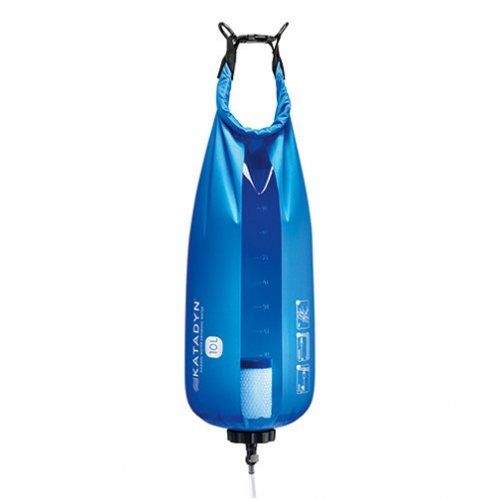
Also consider that the nature of the emergency might mean that water you could have potentially collected is contaminated perhaps by radiation or a chemical spill so it is important to ensure that as well as the preparation you put into you bug out bag you have water stored at home not only in case of water shortages but in case you need to grab a bit more water towards your bug out bag at the last moment. Collecting and purifying water is a topic in and of itself though and you can read more about it HERE.
Food
A 72 hour kit contains three days of food and I would suggest a similar amount is suitable for a bug out bag, especially if you are heading from a bug out location and also because three days of food can be quite heavy. To feed me beyond three days I do include some dried staple foods that are fairly light weight and can be carried in addition to standard rations and which can be used once you have established a regime of foraging, trapping and hunting if you’re emergency comes to that.
For your first three days food though weight is the issue and you will need to carefully consider what to bring to make sure your load is manageable. There is no need to think about a balanced diet for just a 72 hour period and food that is high in calories, warming, tasty and which doesn’t require rehydrating should be your priority. The more calories the better to give you plenty of energy but do consider the water you will save by using at least some food that is not dehydrated, you will always need some dehydrated food to save weight and space or just to supplement your wet food.
The most weight effective wet food to carry are cook in the bag meals like the kind found in military ration packs. These are also available from civilian manufacturers but they are expensive, as your prepare for emergencies though you will realise that some things just cost what they cost and boil in the bag meals are just one of those things that are quite expensive. Definitely don’t pack tin can’s not only are they heavy but they are uncomfortable to carry. Most things that are available in tins are also now available in plastic tubs and this can save a lot of weight. Small plastic tubs of fruit, jello and even puddings that can be steamed over the fire are a great way to add calories to your rations and to improve morale and I would consider them vital if you are preparing to bug out with children.

Breakfast foods are available as boil in the bag options as well to save having to use your precious water to make porridge but porridge oats are light and I always pack some on top my initial three days’ worth of food as they are so versatile.
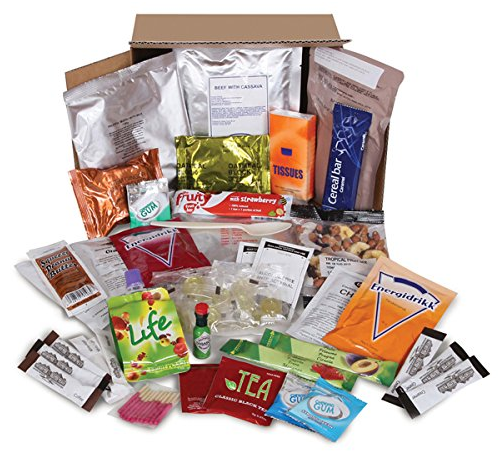
As well as your main meals and breakfast you should pack plenty of snack foods and drinks, biscuits, crackers, potted pate, jerky, dried fruit, candy, nuts etc.. all keep well and are tasty and easy to eat even if you don’t have a chance for a proper meal time. These snacks and hot drinks are great for morale not to mention good for warming you on cold days and again their effect on morale should not be overlooked. Keeping up your morale in stressful emergency situations is absolutely vital. If you go down the route of using military rations for your bug out bag packing is easy; British Military rations are issued as 24 hour packs so three 24 hour ration packs will be plenty for 72 hours, do remember though to take them out of the box they come in and packing them properly to save space. Each US issued MRE is sufficient for a single large meal but also contain snacks so two per day will be sufficient but three would be even better, an advantage of MRE’s is that they contain a water activated cooking pouch for heating your meals so that you can cook without having to light a fire or use a camp stove.
If you choose to use military rations in your bug out bag remember to get a selection of menu’s if you buy in bulk they will almost always come in boxes of one menu. Aim for at least a little variety otherwise you’ll get very tired of beans and sausage and chicken tikka every day.
If you can’t get or prefer not to use military rations, you can opt for civilian boil in the bag meals or consider a menu something like this;
- 3 sachets microwave rice (this can easily be prepared on your camp stove or fire in your cook pot and mixed with some of your dried food to make extra meals or supplement some of your main meals)
- 1kg smoked sausage and/or jerky
- Freeze dried vegetables
- 3 ready to eat microwaveable meals.
- Tube of soft cheese
- Hard tack crackers or oat cakes
- Large bag of dried fruit and nuts
- Sachets of milk powder or coffee whitener
- Hot chocolate, tea and coffee depending on your preference.
- Tube of condensed milk
- Sugar
- Biscuits
- Boiled sweets
- Chocolate
The microwaveable items here obviously don’t need to be microwaved but they are effectively the same stuff as you would find in a boil in the bag meal but much cheaper and don’t require any additional water to be added to them and can just be warmed up on the fire or your stove.
Extra ‘Survival Food’
To supplement your initial three days of food, some light weight dried rations can be carried, once you have established a supply of clean water you can start to use these dried foods. They can also be used to supplement your initial supplies or help them last longer. This is especially important if you are bugging out as a family rather than on your own, if one of your bug out bags is compromised perhaps lost, damaged or in the event of it being stored insecurely and not checked regularly perhaps rodents have got in and destroyed some of your food. In situations like this you will need to make up for the spoiled or lost food especially if you have children to feed.
- 2-3 Instant pasta meal sachets
- 1kg of porridge oats
- 500 grams of mixed lentils and pearl barley
- 200 grams of instant custard powder
- As many stock cubes as you can carry
- Plenty of instant soup sachets
- Small pouches of freeze dried vegetables
As well as this extra food your survival kit should include items which can be used to gain more food, fish hooks, fishing line and snare wire can be used to great effect with a bit of practice and knowledge to catch small game. As well as these small items one thing you should do in preparation for emergencies that you can’t pack into your bug out bag is learn to identify wild edibles and learn how to improvise traps and procure food from the environment. These skills are invaluable and even with food cached at a bug out location, if your emergency is so dire that you need to bug out you are probably going to have to use your survival and foraging skills at some point.
1. Hand Crank/Solar Radio

Staying abreast of developments in an emergency will be very important, short of an EMP wiping out electronic devices there will be emergency broadcasts that you can tune into to make you aware of rescue efforts and other important news. Being able to listen to these will be important as you may get news of where to find lost or injured family members, or important information about places to avoid or head to. A solar powered and/or hand crank radio means you are not reliant on batteries to power this vital little piece of equipment.
2. Survival Knife
Although in many ways packing a bug out bag is like packing a bag for a camping or hiking trip all you really need in way of a knife is a simple pocket knife with a can opener and maybe a saw. For survival scenarios you will need your survival knife like the Fällkniven F1.

Your knife must be robust and up to the tasks presented by emergency survival situations but does not need to replace an axe, I always make space for an axe in a bug out bag as there is no shortage of trees where I live and can absolutely justify the weight of an axe in my bug out bag, at only a few pounds the cutting and chopping ability of an axe is far superior to a knife and if I could only carry one cutting tool in my bug out bag it would be an axe rather than a knife every time. I don’t have to choose only one though so for temperate and arctic woodland environments I would always recommend carrying a knife and axe, in jungle environments a machete and axe combination might be more suitable and perhaps in desert and taiga environments you could dispense with the larger cutting tool altogether and just go with a knife. When selecting a knife for your bug out bag though consider the factors that helped me select the F1 as my top pick for a survival knife;
- Full length tang
- A handle which fully encloses the tang so it can be used comfortably in the cold
- A blade edge which starts as close to the handle as possible
- A small sharpening choil but no finger choil
- A handle impervious to moisture; rubber, plastic, stabilised wood or G10
- A blade around four inches in length
- A convex grind for strength
3. Axe
I have already justified why I would carry an axe in my bug out bag and those of you who live in temperate or arctic woodland environments will probably understand that choice. Do consider you surroundings though; take a machete if you live in the jungle for example, an axe won’t be as useful to you but the larger cutting tool is very useful. I don’t buy the argument that a larger knife can replace an axe and cut down on the weight you carry as you only need one tool instead of two. The larger knife will never cut as well as an axe or machete and will never perform the fine tasks that a smaller survival knife will do as well as the smaller knife. Bite the bullet and plan on carrying both.
I would recommend a mid-sized axe, bigger than a hatchet but not a full size felling axe. Something large enough for limbing and felling small trees but light enough to be used for finer work as well. Something like the Gransfors Bruks Small Forest axe is ideal;
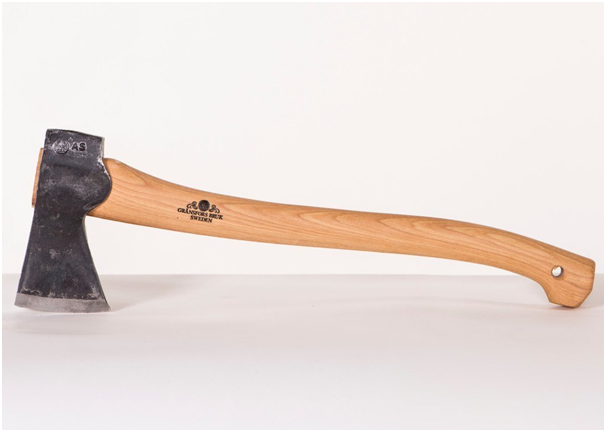
Or for the more budget conscious the Husqvarna multi-purpose;

4. Shelter

We’ve discussed shelter to some extent already and the difficulty of finding a shelter solution that is light enough, especially if you are preparing to bug out with a family. These mylar tents weigh no more than a pound each and packing a few of these will save you the huge burden of a tent. They are also great at making the most of your bodies heat, and the shiny surface will reflect that heat back towards you and if used in conjunction with a fire these shelters are warm enough even without a sleeping bag in temperate climates.
5. First aid and Hygiene
If you or your party suffer any injuries in a survival situation then treating those injuries is you first priority, rendering first aid trumps all other priorities and must be rendered effectively. To this end a first aid kit should always be part of your bug out bag and it must contain the necessaries for treating traumatic injuries. Something like the adventure medical kits trauma pack is ideal;

Shop bought first aid kits will often not include clotting agents and tourniquets as most people do not have training to use them but in a large scale emergency when emergency services may not be able to reach you being able to apply a tourniquet and properly dress a catastrophic haemorrhage could mean the difference between life and death. So as well as basic first aid supplies you must include at least one tourniquet, large field dressings and potentially clotting agents in your first aid kits.
As well as your first aid supplies some hygiene and sanitary items are essential, but you are not packing for holiday or a business trip so don’t think that you need to pack quite as much as you might when you are heading of on vacation. Wet wipes are king when it comes to short term emergencies and that is what I pack for washing as this saves water as well. In short term emergencies that last no more than 72 hours this is all you will need. Sanitary products for ladies will be vital as will nappies for babies if you are having to build a bug out kit for a young child. In case of longer term emergencies a toothbrush will be useful but remember that if we are talking about a world ending disaster you are eventually going to run out of soap and shampoo anyway so there is almost no point packing any, you will either not have time to use it or will run out long before your emergency is over so it’s better to learn how to improvise soap from nature instead of weighing down your kit with unnecessary items.
6. Mess Kit
Your cooking kit is a very important part of your bug out bag, if you have gone with military ration packs for your food you don’t strictly need to cook as the meals can be eaten cold, however being able to cook and prepare hot drinks not only helps keep you warm in cold environments but is a great boost to morale. A cooker is not strictly necessary in environments where wood is plentiful as a fire will not only warm your body without eating into reserves of fuel but is also an incredibly efficient cooking method. In climates where wood may not be plentiful I would recommend packing a stove in your bug out bag and would advise that it be some sort of multifuel stove rather than a stove dedicated to take gas bottles of a certain brand or design to make it more flexible. Something like the MSR WhisperLite;
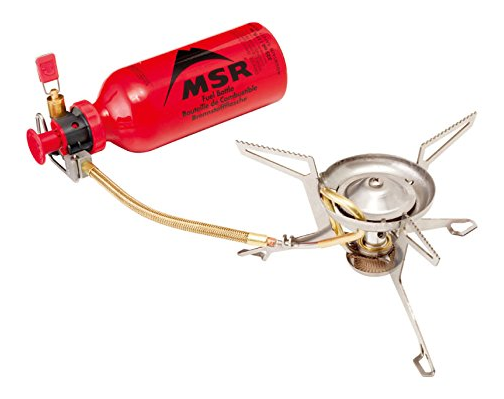
A multifuel stove allows you the flexibility to cook on almost any liquid fuel from gasoline to diesel, white spirit or aviation fuel and you shouldn’t ever struggle to find more fuel for it. As I don’t anticipate being short of fire wood though I pack a much smaller more compact stove that I will only use if for some reason I can’t light a proper fire, or if I need to warm food or drink quickly, perhaps to treat someone with hypothermia, and don’t have time to get a fire lit. Something like the Esbit stove is ideal;
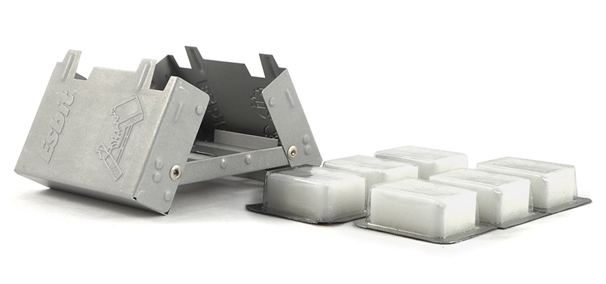
To light your stove or fire some form of ignition is essential, yes with well developed survival skills fire by friction is possible but in emergencies you must have a 100% reliable fire making solution. A jet flame lighter is an ideal solution but must be backed up by other methods of fire lighting included in your survival kit and amongst the things you carry on a daily basis.
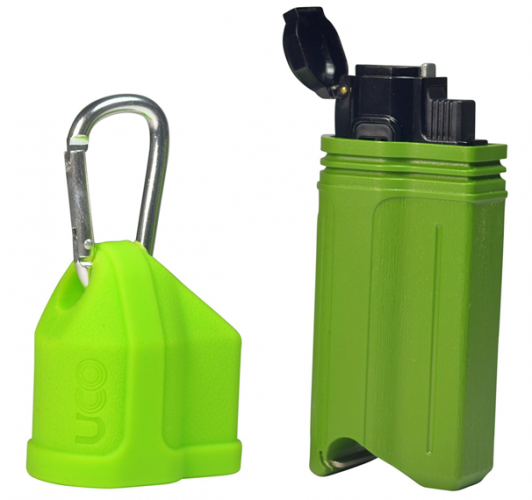
Once you have your source of ignition and have though about a stove or fire for cooking on a cooking pot is next and one of the most important parts of your bug out bag. Without a cooking pot you can’t purify water or cook food and a container is in fact one of the ‘5 c’s of survival’ as made popular by Dave Canterbury of Dual Survival and which he explains in this video. A spoon can also be added to you mess kit but other cutlery is unnecessary.
7. Sleeping Bag
A sleeping bag is a very important part of your bug out bag, many people seem to be advocating the use of heavy woollen blankets for bushcraft and survival at the moment but I would always recommend a sleeping bag even in very warm climates where you may think that they are unnecessary. Even in warm places people can suffer from hypothermia as a result of being drenched in a flood or storm and being able to warm yourself or a member of your family who is suffering may be vital to their survival, sleeping bags are far more efficient at this than wool blankets as long as kept dry and are generally lighter and take up less space in your pack. They are also more comfortable and as we have said before comfort is very important to morale. I would recommend sleeping bags by Mountain Equipment for a good balance of quality and price;

8. Vital documents
We’ve covered vital documents already, you do need to pack them, or at least have them to hand so you can grab them and shove them in your bug out bag at a moment’s notice. They may well make the difference between being able to rebuild your life after an emergency or not. Also consider having to bug out as a family, what if you get separated from each other or an emergency occurs while your children are at school or you are at work even if you get all your kit together in a situation like that how will you get your family together? Perhaps you will have to search for your children in an evacuation centre, in those cases those documents including a recent family photograph will be vitally important as you search for your loved ones.
A local map is also an important document to include in your bug out bag, especially if you have a bug out location to head for or a rendezvous point arranged with your family or a cache of food and equipment stored somewhere for emergencies, all these things should be marked on your map.
9. Flashlight
A flashlight is a vital part of your bug out bag as well as something I would strongly advise you to carry on an everyday basis. Having a light you can use hands fee is very important too you may need to keep your hands free while you cook over the fire, set up a shelter in the dark, perform first aid or any number of other important tasks.
My favourite at the moment is the Olight H1, it is a pocket sized, and very bright LED flashlight that comes with a simple headband turning it into an effective hands free head lamp;

10. Survival Kit
A survival kit isn’t really a single item but rather a collection of vital pieces of equipment; it’s this, your axe and knife and your extra ‘survival food’ that really separates your bug out bag from a 72 hour kit. A survival kit should contain extra fire lighting and water purifying tools as these are both absolutely vital for short term survival let alone survival on the long term. It should also contain basic survival equipment to help you being to establish a stock of food beyond what is in your bug out bag already. Fish hooks, split shot, a catapult and ammunition, fishing line, strong wire and cordage for making snares, arrow heads and other basic equipment doesn’t take up much weight or space and can be very effective in skilled hands. You can buy ready made survival kits but I would always recommend building your own as the important, and most versatile, equipment like fishing line and cord tends to be featured in shop bought kits in only very small quantities and valuable space is taken up by poor quality gimmicky kit that isn’t useful.
Instead I would recommend the following, it may take up a little more space that a shop bought kit but it will be far more useful;
- 30 meters 550 paracord
- 2 sets of catapult elastic
- 20 steel or lead catapult shot sprayed a bright color to help you find them
- 200 meters of fishing line half in 20-30lb breaking strain and half in 6lb breaking strain
- 20-30 fish hooks of various sizes
- 10-20 split shot for fishing
- Small but good quality compass by Silva or Suunto or other reputable manufacturer (do not skimp on a compass).
- 3 broad head arrow heads (these can be fitted to a shaft and fired from an improvised bow or from your catapult)
- 20 meters of braided wire for snares
- Bright orange survival bag for signaling and emergency shelter
- Extra esbit fuel to help with fire lighting
- Ferrocerium rod
- Lifeboat matches
What no Guns?
Guns often form part of peoples bug out bag but because there are so many places in the world where guns are not accessible to everyone that might be preparing for emergencies I don’t consider them a vital part of a bug out bag certainly in the event of flood, house fire or other localised emergency grabbing a gun is not going to be my priority, other than perhaps to save them from being destroyed and even then I won’t risk my life to get my guns out of a house fire, the insurance can pay out for that if it’s that bad, I’d rather get my family to safety and my bug out bag will be far more useful to me than my guns in that situation. If there was an entire breakdown of civilisation and society as we know it then maybe a gun would be more important to me not because I fear zombies or cannibals as most post-apocalyptic movies would have you believe is an integral part of emergencies but because in those instances they become valuable game getting and self-defence tools.
But purely because so many people don’t have guns or are bound by laws that demand their firearms remain locked up when not in use they do not feature in my list of MUST HAVE items for bugging out.
If I had to choose one gun for bugging out though it would be a combination gun, these are fairly unusual nowadays and if you aren’t familiar with them you can check one out on youtube here;
They can be expensive but they can be very versatile for game getting. My favourite combination is 12 gauge and .222 which with the right ammunition can be used to effectively game of all sizes with the right ammunition.
Conclusion
With all the basics and now these ten vital items considered and prepared double check you bug out bag and ask yourself if you have met all your survival needs; does your bug out bag provide you with the following?
- Shelter
- Food
- Water
- Fire
All these four basic necessities MUST be provided by your bug out bag. In any survival situation, these things will be essential, in fact even in everyday life these are among those few things we could never do without. Think of the importance of water for washing and drinking, and food, and what our homes, clothes, cars, and umbrellas but shelter? Isn’t it fire in one form or another that cooks our food and warms our homes? Just as these things are essential in everyday life they will be even more important in our preparations for an emergency, so prepare your bug out bag NOW.
Geoff has a background as a professional game and deer manager. He has put his years of experience to good use and now lectures at Hartpury College, one of the UK’s leading providers of land-based education.
He specializes in training game and wildlife managers who will work in professional game management, conservation, and other outdoor professions. He's been teaching at colleges for eight years and, in that time, has worked at some of the most prestigious land-based colleges in Britain.








